Accepted Scientific Name: Pterocactus tuberosus (Pfeiff.) Britton & Rose
Cactaceae (Britton & Rose) 1: 32. 1919 [21 Jun 1919] Britton & Rose
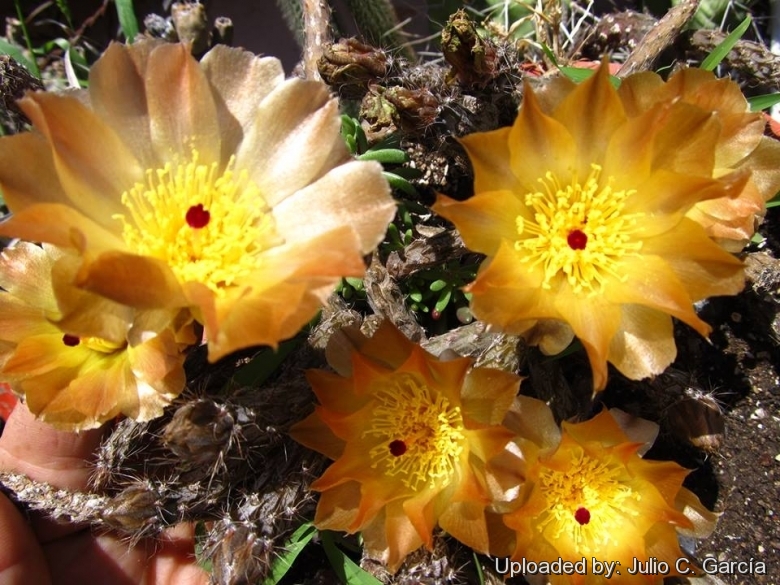
Opuntia tuberosa (Pterocactus tuberosus) Photo by: Julio C. García
Origin and Habitat: Northern Argentina from Rio Negro in the south to Salta in the north and Patagonia ( (Buenos Aires, Catamarca, Córdoba, La Pampa, La Rioja, Mendoza, Neuquén, Rio Negro, Salta, San Juan, San Luis, Tucumán).
Altitude range: It grows at elevations of 0 to 2,500 metres above sea level.
Habitat: The species is found in monte shrubland. It grows in sandy and sometimes salty soil and is one of the typical dune dweller species, that have most of their mass buried in the sand.
Ecology: This plants have a peculiar reproductive mechanism: they have the ability to lose their sprouts in autumn and winter. These plants often loose all their top growth in the dormant season in habitat. These bracken segments are then spread by strong winds and volatile sands, and can give origins to new plants in the next vegetative season. The Pterocactus tuberosusSN|1126]]SN|1126]] tuberose roots will grow new floriferous stems again. This species it has a wide range amd there are no major threats. It is not abundant but the population is stable, and it occurs in protected areas.
Synonyms:
See all synonyms of Pterocactus tuberosus
back
Accepted name in llifle Database:Pterocactus tuberosus (Pfeiff.) Britton & RoseCactaceae (Britton & Rose) 1: 32. 1919 [21 Jun 1919]Synonymy: 8
back
Description: Pterocactus tuberosusSN|1126]]SN|1126]] is a geophyte cactus with huge tuberous roots under the soil ,with thin fragile blue-light to brownish-purple stems that breaks off easily. Many different forms exist.
Root: Tuberous root, up to 8 cm thick, deeply set in the ground . All pterocacti have a tuberous root system from which the stems sprout and sprawl around.
Aerial stem-segments: 7-20(-40) cm long, 0,8-1,5 cm in diameter. brown or greenish brown. with a vertical violet line below the areoles. Each stem flowers at its tip before branching.
Spines: 8-12 5-10 mm long whitish.
Flowers: The flowers are terminal produced from the apex of new growth and without a tube. 1-5 cm in diameter, pale to deep yellow, brownish or coppery. Perianth segments erect. Stigma almost white, pink or to deep red.
Fruit: Dry.
Seeds: White, and differing from all other cactus seeds in being winged, 10-12 mm in diameter (including the wing).
Subspecies, varieties, forms and cultivars of plants belonging to the Pterocactus tuberosus group
Notes: The genus Pterocactus belong to the subfamily Opuntioideae and has been given its own tribe, the Pterocacteae.
Bibliography: Major references and further lectures
1) Nathaniel Lord Britton, Joseph Nelson Rose “Cactaceae: Descriptions and Illustrations of Plants of the Cactus Family” Courier Dover Publications, 1963
2) Edward Anderson “The Cactus family” Timber Press, Incorporated, 2001
3) James Cullen, Sabina G. Knees, H. Suzanne Cubey "The European Garden Flora Flowering Plants: A Manual for the Identification of Plants Cultivated in Europe, Both Out-of-Doors and Under Glass" Cambridge University Press, 11/Aug/2011
4) David R Hunt; Nigel P Taylor; Graham Charles; International Cactaceae Systematics Group. "The New Cactus Lexicon" dh books, 2006
5) Haustein, Erik “Der Kosmos-Kakteenführer” Kosmos (franckh-kosmos) 1998
6) Edgar Lamb, Brian Lamb “The Illustrated Reference on Cacti & Other Succulents” Volume 5 Blandford Press, 1978
7) John Borg “Cacti: a gardener's handbook for their identification and cultivation” Blandford P., 1970
8) Demaio, P., Perea, M. & Trevisson, M. 2013. Pterocactus tuberosus. The IUCN Red List of Threatened Species. Version 2014.3. <www.iucnredlist.org>. Downloaded on 09 April 2015.
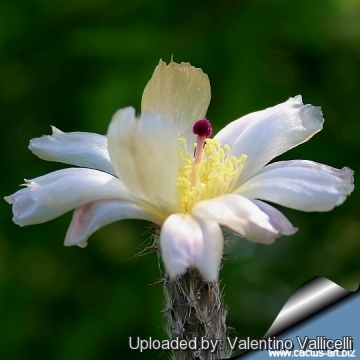 Opuntia tuberosa (Pterocactus tuberosus) Photo by: Valentino Vallicelli
Opuntia tuberosa (Pterocactus tuberosus) Photo by: Valentino Vallicelli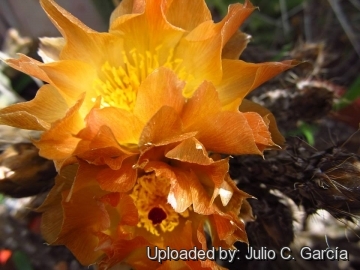 Opuntia tuberosa (Pterocactus tuberosus) Photo by: Julio C. García
Opuntia tuberosa (Pterocactus tuberosus) Photo by: Julio C. García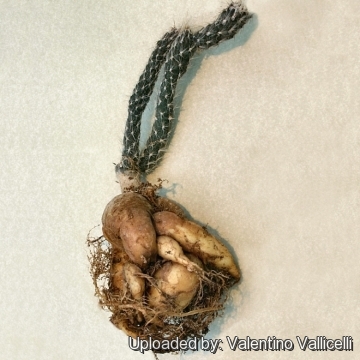 Opuntia tuberosa (Pterocactus tuberosus) Photo by: Valentino Vallicelli
Opuntia tuberosa (Pterocactus tuberosus) Photo by: Valentino Vallicelli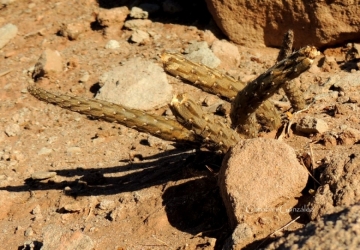 In habitat. (Neuquén province, Argentina) (Pterocactus tuberosus) Photo by: Carolina González
In habitat. (Neuquén province, Argentina) (Pterocactus tuberosus) Photo by: Carolina González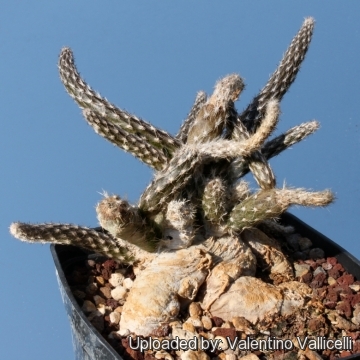 Opuntia tuberosa (Pterocactus tuberosus) Photo by: Valentino Vallicelli
Opuntia tuberosa (Pterocactus tuberosus) Photo by: Valentino Vallicelli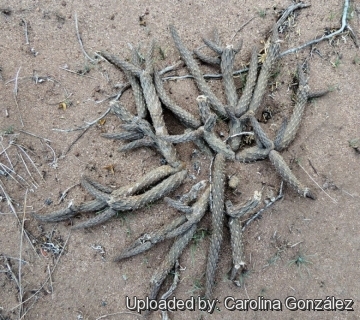 Habit at Villa El Chocón at the end of May, Neuquén province, Argentina. (Pterocactus tuberosus) Photo by: Carolina González
Habit at Villa El Chocón at the end of May, Neuquén province, Argentina. (Pterocactus tuberosus) Photo by: Carolina González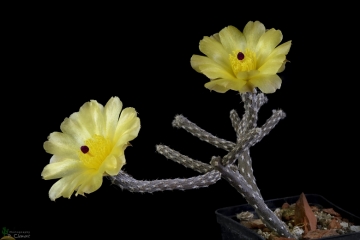 Opuntia tuberosa (Pterocactus tuberosus) Photo by: Peiffer Clement
Opuntia tuberosa (Pterocactus tuberosus) Photo by: Peiffer Clement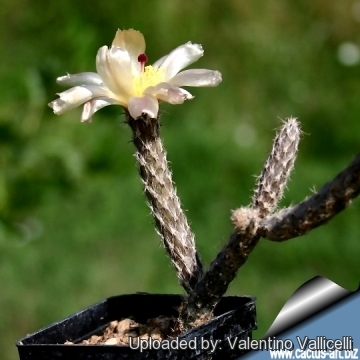 The flowers form apically at the tip of stems. (Pterocactus tuberosus) Photo by: Valentino Vallicelli
The flowers form apically at the tip of stems. (Pterocactus tuberosus) Photo by: Valentino VallicelliCultivation and Propagation: Pterocactus tuberosusSN|1126]]SN|1126]] is easy to grow, provided it is kept cool, but dry during autumn and winter. It is a particular favourite of caudiciform plant enthusiasts.
Growth rate: Plants grow very slowly and caudex take many years to enlarge. Clustering in cultivation, if grown correctly, it will reward the grower with generous displays of flowers.
Caudex exposure: The remarkable tuberous rootstock (caudex) is often raised above the soil line so that this can be seen and more readily appreciated. For best results the tuber must be exposed only when plans become mature enough, usually after several years of underground growth, as the exposed caudex will no longer increase in size once it has been lifted above the soil line.
Potting medium: Use a cactus mix or add extra perlite or pumice to regular soil potting soil. A gritty, very free-draining compost is suitable, and clay pots help the plants to dry out between watering. For best results, use a deep pot.
Fertilization: Need a perfect fertilizer diet in summer. Use preferably a cacti and succulents fertilizer with high potassium content including all micro nutrients and trace elements or slow release fertilizer.
Watering Needs: Water normally in the growing season from March to October. No water should ever be allowed to stand around the roots. Keep almost completely dry in winter. The swollen caudex makes it very tolerant of under watering.
Hardiness: It is quite frost resistant if kept dry, hardy as low as -15° C. It can be grown outdoors in the summer months to benefit from direct exposure to light, and especially exposure to high summer temperatures. Recommended Temperature Zone: USDA 9-10.
Sun Exposure: It is essential to give full sun; otherwise they will become atypical. If grown in full sun, the new growth will flower profusely in spring and summer.
Rot: Rot it is only a minor problem with pterocacti if the plants are watered and “aired” correctly. If they are not, fungicides won't help all that much. The plant turns immediately to mush when over watered, or watered out of season. Care must be given in watering, keeping them warm and wet while growing, and cooler and dry when dormant.
Maintenance: Most of the slender stems become detached during winter, but some advise to help the plant by pruning all the top growth in autumn, to encourage it to produce stems with terminal flowers in the spring.
Grafting stock: Pterocactus tuberosusSN|1126]]SN|1126]] tuber is sometime used as an hardy grafting stock for south-American cacti like Tephrocactus malyanusSN|4175]]SN|4175]]. The flat graft system is usually adopted when using a stock of this type, and it is far better than Pereskia.
Reproduction: Seeds or cuttings. The seed should be planted in spring. Germination usually occurs within about one week to one month. Seed germinate at 15-21 °C.
Your Photos
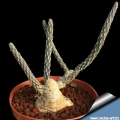
by Valentino Vallicelli

by Valentino Vallicelli

by Valentino Vallicelli

by Carolina González

by Valentino Vallicelli























